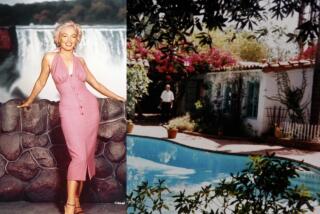Friars Club’s old Beverly Hills home tumbling down
The 1961 building in Beverly Hills that once housed the Friars Club, where Jack Benny, Gary Cooper and other Hollywood kingpins engaged in cheeky character assassinations at lavish, alcohol-soaked dinners, is being razed.
Demolition of the building at 9900 Santa Monica Boulevard began last week and is expected to take just a few days. The structure housed the West Coast branch of the private entertainers club until 2007, when the New York Friars prevailed in a lawsuit that forced the Beverly Hills group to change its name. The name was changed to Club 9900 in 2008 but the club was closed soon after.
Public records list the owner of the building as Chartwell Sports, a limited partnership. Chartwell has the same Century City address as a number of other Chartwell entities that list as their president A. Jerrold “Jerry” Perenchio, the billionaire former chief executive of Univision Communications Inc. He could not be reached for comment.
The Los Angeles Conservancy decried the destruction, saying it signified the continued erosion of the region’s legacy of 1960s architecture and underscored the need for stronger local preservation measures.
“Unfortunately, many people don’t yet understand why a building like this is worth saving,” Adrian Scott Fine, director of advocacy for the conservancy, said in a statement. “This is an important building by an important architect, and it will very soon be lost to us forever. … It’s unique in terms of its original function and association with mid-century L.A. and celebrity culture.”
The building was designed by Sidney Eisenshtat, a prominent Los Angeles-based architect who died in 2005. It featured a windowless Space Age façade with specially designed ceramic tile and imported marble. The building was included in a 2006 survey of commercial structures in Beverly Hills and identified as being eligible for listing in the California Register of Historical Resources for its association with the Friars Club, as well as for its architectural significance.
Unlike Los Angeles, Beverly Hills has no preservation ordinance, said Jonathan Lait, Beverly Hill’s assistant director of community development. However, he said, starting in the next fiscal year the city plans to explore use of the state Mills Act, which provides tax credits for property owners who preserve historic structures.
“That would be a good step forward for preservation in Beverly Hills,” Lait said.
Lait said the owner was demolishing the building but had revealed no immediate plans to rebuild. The issuance of a demolition permit in such a case requires no environmental review.
“If they had presented a replacement project to us that would have required some discretionary review, that would have been a different story,” he said. “We would not have issued a demolition permit until we fully understood the new project and the potential historic loss of the Friars Club.”
A Jan. 22, 1961, story in The Times announcing the start of construction on the $750,000 club headquarters said the three-story building would feature a cocktail lounge, main dining room and other rooms with collapsible walls that could open up to provide a 600-seat auditorium.
One attraction of Friars Clubs on both coasts was the “round-table atmosphere of comics swapping stories,” said Monty Hall, a producer and entertainer best known as former host of the TV game show “Let’s Make a Deal.” “As that diminished, so did the interest.”
In the late 1960s the Beverly Hills club experienced months of notoriety. A federal grand jury began investigating allegations of crooked card games for stakes as high as $100,000 at the club. Singer Tony Martin, comedian Phil Silvers and shoe millionaire Harry Karl were among those who testified that they had lost big.
When Silvers, the former Sgt. Bilko of TV fame, testified to the grand jury, reporters asked whether he had suffered heavy losses. Silvers quipped: “Let’s put it this way: Is that the freeway? I’m hitchhiking home.”
More to Read
Sign up for Essential California
The most important California stories and recommendations in your inbox every morning.
You may occasionally receive promotional content from the Los Angeles Times.











